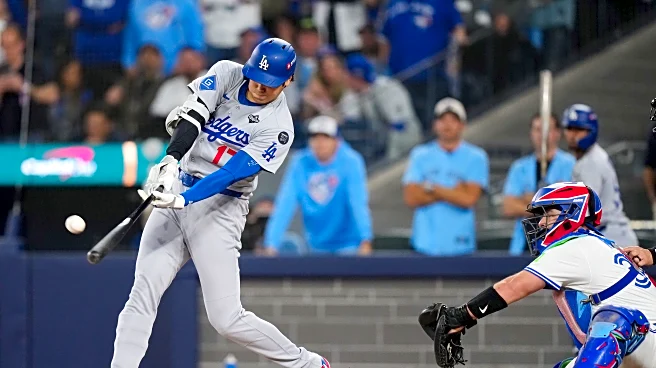What's Happening?
Addison Barger of the Toronto Blue Jays made history with a pinch-hit grand slam in Game 1 of the World Series against the Los Angeles Dodgers. Following his performance, Barger was offered a special T-shirt
by former Red Sox player David Ortiz, a tradition for players who excel in October. The shirt features Ortiz's image and the phrase 'My Dawg.' However, Barger left the shirt behind, citing his reluctance to wear apparel associated with a division rival, the Red Sox. The incident provided a humorous moment for former Yankees Derek Jeter and Alex Rodriguez, who were present during the postgame interview.
Why It's Important?
Barger's decision to leave behind Ortiz's gift highlights the deep-rooted rivalries within Major League Baseball, particularly between teams in the same division. This moment underscores the cultural significance of team loyalty and the competitive spirit that defines professional sports. Barger's actions resonate with fans who value team allegiance over individual accolades, reflecting the broader dynamics of sports fandom. The incident also illustrates the playful interactions between baseball legends and current players, contributing to the narrative of sportsmanship and camaraderie.
What's Next?
As the World Series progresses, Barger and the Blue Jays will continue to focus on their performance against the Dodgers. The humorous exchange over Ortiz's gift may become a lighthearted anecdote in the series' narrative, but the focus remains on the games ahead. The Blue Jays aim to capitalize on their Game 1 victory and maintain momentum in the series. Meanwhile, Ortiz's tradition of gifting shirts may continue, with players potentially embracing or rejecting the gesture based on team loyalties.
Beyond the Headlines
The incident with Ortiz's shirt highlights the cultural and emotional aspects of sports rivalries, where team identity can overshadow individual achievements. It also reflects the broader theme of sports as a unifying yet divisive force, where allegiances shape interactions and perceptions. This moment may spark discussions on the role of traditions and gestures in sports, examining how they contribute to the narrative and identity of teams and players.












